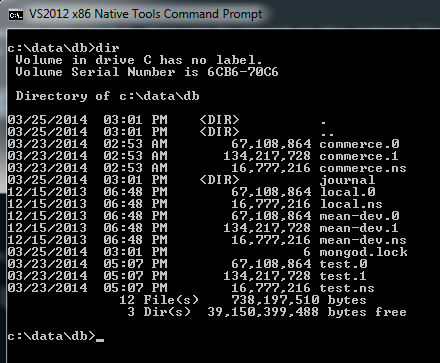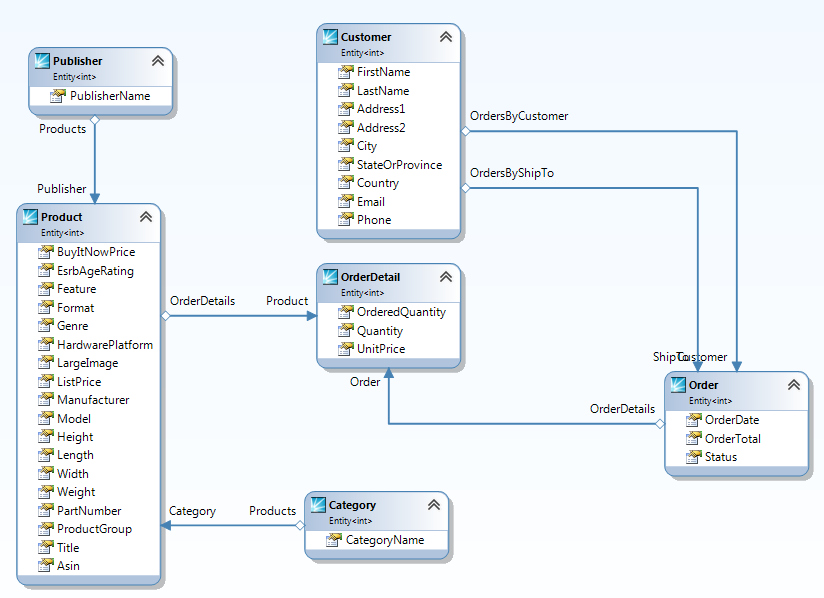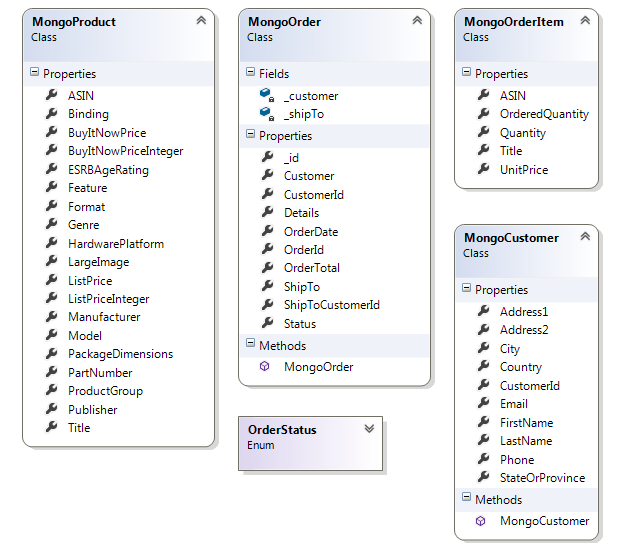Using Mongodb in .NET
by
Joe Feser
of
Logical Advantage
@joefeser Twitter
joefeser github
What is it?
MongoDB is an open-source NoSQL database used by companies of all sizes, across all industries and for a wide variety of applications. It is an agile database that allows schemas to change quickly as applications evolve, while still providing the functionality developers expect from traditional databases, such as secondary indexes, a full query language and strict consistency.
http://www.mongodb.com/mongodb-overview
Features
-
JSON Data Model with Dynamic Schemas
-
Auto-Sharding for Horizontal Scalability
-
Built-In Replication for High Availability
-
Rich Secondary Indexes, including geospatial and TTL indexes
-
Text Search
-
Aggregation Framework & Native MapReduce
-
Hadoop Integration
-
Drivers: 10 MongoDB-Supported Drivers; 40 Community-Supported Drivers
http://www.mongodb.com/mongodb-overview
Drivers in many languages
JavaScript
Python
Ruby
PHP
Perl
Java
Scala
C#
C
C++
Haskell
Erlang
Use Cases
MongoDB is a general purpose database suitable for most applications and use cases.
http://www.mongodb.com/use-cases
Use Cases
-
Big Data
-
Content Management and Delivery
-
Customer Data Management
-
Data Hub
-
Database-as-a-Service
-
Internet of Things
-
Mobile Apps
-
Product and Asset Catalogs
-
Security and Fraud Apps
-
Social and Collaboration Apps
http://www.mongodb.com/use-cases
Setting up mongodb
Download the latest build

http://www.mongodb.org/downloads
Unzip the files

I use c:\mongodb\bin
Create a folder for the data

The default is c:\data\db
This is the default folder on the same drive as mongod.exe. You can also pass a different folder as a command line option (dbpath).
Start MongoD

From the c:\mongodb\bin folder
More Information
http://docs.mongodb.org/manual/tutorial/install-mongodb-on-windows/
Terms vs Sql Server
| SQL Terms/Concepts | MongoDB Terms/Concepts |
| database | database |
| table | collection |
| row | document or BSON document |
| column | field |
| index | index |
http://docs.mongodb.org/manual/reference/sql-comparison/
Terms vs SQL Server
| SQL Terms/Concepts | MongoDB Terms/Concepts |
| table joins | embedded documents and linking |
| primary key | primary key |
| Specify any unique column or column combination as primary key. | In MongoDB, the primary key is automatically set to the _id field. |
| aggregation (e.g. group by) | aggregation pipeline |
http://docs.mongodb.org/manual/reference/sql-comparison/
Data types
-
Object id
-
Integer 32 / 64 bit
-
Double
-
String
-
Object
-
Array
-
Binary data
-
Boolean
-
Date
-
Null
BSON Data types
- Type
- Double
- String
- Object
- Array
- Binary data
- Object id
- Boolean
- Date
- Null
- Regular Expression
- JavaScript
- Symbol
- JavaScript (with scope)
- 32-bit integer
- Timestamp
- 64-bit integer
- Min key
- Max key
http://docs.mongodb.org/manual/reference/bson-types/
How to connect to MongoDB from .Net
-
Configure a connection
-
Create a MongoClient object
-
Create a MongoServer
-
Get access to a MongoDB database
-
Consider using static properties
How to connect to MongoDB from .Net
public static string connectionString = "mongodb://localhost"; public static MongoClient Client = new MongoClient(connectionString); public static MongoServer Server = Client.GetServer(); public static MongoDatabase MainDatabase = Server.GetDatabase("commerce");
How do you access MongoDB collections
The MongoDatabase object has a method on it called GetCollection<T> allowing you a strongly types object reference.
You are not limited to storing one type of object in a collection, but I do to keep from making mistakes, not having _id collisions, and to keep sane.
public static MongoCollection<MongoProduct> ProductCollection = Mongo.MainDatabase.GetCollection<MongoProduct>("product");
How to set up your classes for serialization
By default, all of your properties will be serialized, as long as they are not read only (only a get)
There are many ways to set up your objects for serialization. This gives you total control over how your objects are serialized and deserialized
You can use POCO objects with no markup using the BsonClassMap
How to set up your classes for serialization
Custom Attributes
[BsonIgnoreIfNull] [BsonElement("esrb")] public string ESRBAgeRating { get; set; } [BsonElement("format")] public string Format { get; set; }
How to set up your classes for serialization
BsonClassMap
This will be a very familiar pattern for those that are used to AutoMapper
BsonClassMap.RegisterClassMap<MongoProduct>(cm => { cm.AutoMap(); cm.SetIgnoreExtraElements(true); cm.UnmapProperty(c => c.BuyItNowPrice); cm.GetMemberMap(c => c.Format).SetIgnoreIfNull(true); cm.GetMemberMap(c => c.Genre).SetIgnoreIfNull(true); });
How to set up your classes for serialization
Decimal types are not supported!
How do I save them so they are not saved as strings?
How to set up your classes for serialization
Your best bet is to convert the value to an integer or long data type.
Pick a common scale for all decimals in a type (or globally) so the user will not have to guess how to convert your value back
How to set up your classes for serialization
Using another property in your class to serialize the object.
Not as clean but no mapper is needed.
This is problematic for query operations in c#.
[BsonElement("listPrice")] public int ListPriceInteger { get { return (int)(ListPrice * 10000); //4 dec places } set { ListPrice = value / 10000; } } //MSRP [BsonIgnore] public decimal ListPrice { get; set; }
How to set up your classes for serialization
Create a serializer and use that in your BsonClassMap to write the value
BsonClassMap.RegisterClassMap<Dimension>(cm => { cm.AutoMap(); cm.GetMemberMap(c => c.Height).SetSerializer(new DecimalSerializer()) .SetElementName("height"); cm.GetMemberMap(c => c.Length).SetSerializer(new DecimalSerializer()) .SetElementName("length"); cm.GetMemberMap(c => c.Weight).SetSerializer(new DecimalSerializer()) .SetElementName("weight"); cm.GetMemberMap(c => c.Width).SetSerializer(new DecimalSerializer()) .SetElementName("width"); });
How to set up your classes for serialization
This is the original Dimension class. It is a POCO. All operations are performed in the BsonClassMap
public class Dimension { public decimal Length { get; set; } public decimal Height { get; set; } public decimal Width { get; set; } public decimal Weight { get; set; } }
What does this look like in MongoDB?
"dimensions" : {
"length" : NumberLong(100400),
"height" : NumberLong(5000),
"width" : NumberLong(90100),
"weight" : NumberLong(14100)
}
More information
-
http://docs.mongodb.org/ecosystem/tutorial/serialize-documents-with-the-csharp-driver/
-
http://docs.mongodb.org/ecosystem/tutorial/use-csharp-driver/
Retrieving data
Retrieving one record
var query = Query<MongoProduct> .Where(item => item.ASIN == asinName); var asin = Collections.ProductCollection.FindOne(query);
Retrieving data
Retrieving all items that are less than .1 lbs
var query = Query<MongoProduct> .Where(item => item.PackageDimensions.Weight < .1m); var itemsVeryLight = Collections.ProductCollection .FindAs<MongoProduct>(query).ToList();
Retrieving data
Projecting just the needed values to save processing and bandwidth.
The "Id" property will always be set
//does work var asin2 = Collections.ProductCollection.Find(query) .SetFields(Fields.Include("listPrice", "title")).FirstOrDefault(); //does not work var asin2a = Collections.ProductCollection.Find(query) .SetFields(Fields.Include("ListPriceInteger", "Title")).FirstOrDefault(); //must be the c# class properties. var asin3 = Collections.ProductCollection.Find(query) .SetFields(Fields<MongoProduct>.Include(c => c.ListPriceInteger, c => c.Title)).FirstOrDefault();
retrieving Data
Find
FindOne
Saving data
If you know that without a doubt that the object does not exist with the same id, you can use insert.
var product = new MongoProduct() { }; Collections.ProductCollection.Insert<MongoProduct>(product);
Saving data
If you are not sure if the id exists or you are performing an update, use the save method. This method will determine if an insert or update must happen.
If you want it to fail if the object already exists and you want it to be a new record, call insert. Save will override whatever is in the database
var product = new MongoProduct() { }; Collections.ProductCollection.Save<MongoProduct>(product);
Bulk Inserts
If you have many objects to insert at once and they are all inserts, you can use the InsertBatch method.
It takes in an IEnumerable<T>.
It is very fast. For the sample data, 25,000 records were inserted in 1600 ms
Collections.ProductCollection.InsertBatch<Product>(list);
Atomic Updates
-
There is no concept of a pessimistic lock
- Atomic updates are per document
- Reading, modifying the document and saving is not atomic
- Transactions do not exist
Atomic Updates
findAndModify is the MongoDB method that performs atomic updates.
You provide the method with:
-
A Query (optional)
-
A Sort operator (optional)
-
If the document should be removed
-
The Update Statement
-
If you want the new document returned
-
The fields to return (optional)
-
If an upsert should be performed
-
The values to push if the item is new (optional)
Atomic Updates
We have a collection that is storing the view counts for each product in our system. When a user views the page, we want to increment a counter and also set the last view time. Optionally we want to add a keyword that was used when the user searched.
var asinName = "B00000J1TX"; var query = Query.And(Query.EQ("_id", asinName)); var sortBy = SortBy.Null; var update = Update.Inc("counter", 1).Set("lastView", DateTime.Now) .SetOnInsert("keywords", new BsonArray(new[] { "new" })); var result = Collections.ProductViewCollection .FindAndModify(query, sortBy, update, true, true); var found = Collections.ProductViewCollection.FindOne(query);
Atomic Updates
-
findAndModify will only update one record, no matter how you use it.
-
If multiple documents need to be updated, you must use the Update method.
- Each document update will be atomic but the update as a whole will not
- If there is a failure while performing your update, there is no way to know which documents were updated and which ones were not.
Atomic Updates
Update all documents in the collection
var update = Update.Inc("counter", 1); var result = Collections.ProductViewCollection .Update(null, update);
Atomic Updates
Updating all documents that contain a keyword and only add a new keyword if it does not already exist.
var array = new List<string>() { "new" }; var query = Query<MongoProductView>.All(item => item.Keywords, array); //show that we did return a product. var found = Collections.ProductViewCollection.Find(query).ToList(); //Add keyword to all documents that have a keyword of new var update = Update.AddToSet("keywords", "test"); //you could also use push if you wanted it added no matter what. //var update = Update.Push("keywords", "test"); Collections.ProductViewCollection.Update(query, update);
What an e-commerce database would look like in SQL Server

What an e-commerce database would look like in MongoDB
-
Foreign Keys do not exist in MongoDB
-
You may use References or store the data in the document
- Depending on how often you need to display or work with those values will dictate if you have denormalized data
MongoDB Model

Adding a new column
ALTER TABLE ProductView
ADD extra nvarchar(10)
var update = Update.Set("extra", ""); var result = Collections.ProductViewCollection .Update(null, update);
Removing a column
ALTER TABLE ProductView
DROP COLUMN extra
var update = Update.Unset("extra"); var result = Collections.ProductViewCollection .Update(null, update);
Creating an index
CREATE INDEX idx_counter
ON ProductView(counter)
Collections.ProductViewCollection.EnsureIndex(IndexKeys<MongoProductView> .Ascending(item => item.Counter), IndexOptions.SetBackground(true));
Drop Table
DROP TABLE ProductView
Collections.ProductViewCollection.Drop();
Select all records from collection
Select * from ProductView
Collections.ProductCollection.FindAll();
select records with an order by
Select * from Product where asin = '123'
order by Title
Collections.ProductCollection.Find(query) .SetSortOrder(SortBy<MongoProduct>.Ascending(item => item.Title));
Get the count of rows
Select count(*) from Product where ListPrice < 4.99
var query = Query<MongoProduct>.Where(item => item.ListPrice < 4.99m); var count = Collections.ProductCollection.Count(query);
Get the Distinct values of a column
Select Distinct(Title) from Product
Collections.ProductCollection.Distinct("Title", query);
MAp Reduce
-
MongoDB has built in functionality to perform Map Reduce
-
It is much easier to get up and running than Hadoop
-
Can be used as a connector for Hadoop
http://docs.mongodb.org/ecosystem/tutorial/getting-started-with-hadoop/
http://docs.mongodb.org/ecosystem/use-cases/hadoop/
Aggregation Framework
This is an alternative to using Map Reduce
Results must be less than 16mb (document max)
Challenges of migrating to MongoDB for a SQL Server user
-
"Like" Statements are very slow
-
Full Text search can only exist for one field per collection
- If a value changes on a denormalized field, you must perform an update statement to keep the values in sync
- Update statements are not intuitive
- No transactions across multiple rows (documents)
- Two phase commits difficult to understand and keeping state for a rollback is even more difficult
Search can be solved
-
ElasticSearch is an option and is free
-
Requires MongoDB be set up as a Replica Set
http://docs.mongodb.org/manual/tutorial/convert-standalone-to-replica-set/
http://www.elasticsearch.org/
Two Phase commits
-
It is possible and allows for massive scale out but you need a coordinator
- Additional reading can be found at
http://docs.mongodb.org/manual/tutorial/perform-two-phase-commits/
Information about Text indexes
http://docs.mongodb.org/v2.4/reference/command/text/
http://docs.mongodb.org/v2.4/core/index-text/#index-feature-text
More information
- Mongodb open data day 2014: http://www.slideshare.net/davidjeet/mongodb-open-data-day-2014
- Configuration options: http://docs.mongodb.org/manual/reference/configuration-options/
- Manual: http://docs.mongodb.org/manual/
- Using the driver: http://docs.mongodb.org/ecosystem/tutorial/use-csharp-driver/
- Serialization: http://docs.mongodb.org/ecosystem/tutorial/serialize-documents-with-the-csharp-driver/
- CSharp Driver LINQ Tutorial: http://docs.mongodb.org/ecosystem/tutorial/use-linq-queries-with-csharp-driver/
- Windows Azure: http://docs.mongodb.org/ecosystem/platforms/windows-azure/